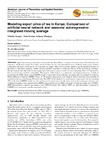Modeling export price of tea in Kenya: Comparison of artificial neural network and seasonal autoregressive integrated moving average

View/
Date
2014-12-19Author
Ikonya, Mbiriri
Mwita, Peter N.
Wanjoya, Anthony
Metadata
Show full item recordAbstract
Agriculture sector is a key driver of economic growth in Kenya. It remains the main source of livelihood for the
majority of the Kenyan people. Tea, coffee, and horticulture are the main agricultural exports in Kenya. Export price of these
commodities fluctuates mainly due to law of demand and supply. Other reasons include; quality of goods and inflation effect on
the dollar or other hard currencies. Further, farmers and their cooperative societies are affected by the local foreign exchange.
The government and other stake holders require prior information on price trends for ease of planning. Thus it is important to
forecast export prices of these commodities. The purpose of this study is to compare the forecasting performance of artificial
neural network (ANN) model and a SARIMA model in export price of tea in Kenya. Secondary data was obtained from Kenya
National Bureau of Statistics (KNBS). A total of 185 monthly export prices were obtained. A three layer feed-forward artificial
neural network was trained using 70% of the data. The ANN model obtained was used to predict export prices for the remaining
30% of the data. SARIMA model was also used to predict export prices for the same duration. Forecasting performance was
evaluated using Root mean squared errors (RMSE), mean absolute error (MAE) and mean absolute percentage error (MAPE).
ANN demonstrated a superior performance over SARIMA model. The authors' ANN has high performance compared to
SARIMA and can accurately predict export price of tea.
Keywords: Artificial Neural Network (ANN), Seasonal Autoregressive Integrated Moving Average (SARIMA),
Kenya National Bureau of Statistics (KNBS)
